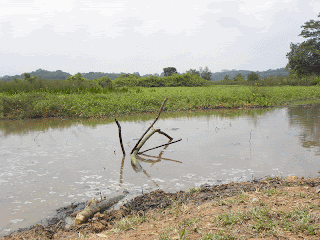By Gerard Francis
You probably trample on many of these wildflowers without a second thought but look closer and find a world of beauty. Kranji Marsh is a great place to enjoy the wildflowers. Look for them on the grass verges of the road and paths where these low growing plants can get the sun. They climb the trees and shrubs and grow in the ponds. The ones pictured here are common. They are native to our region or were introduced a long time ago and have become widespread and naturalized. Many have found traditional uses as indigenous medicines or foods.
Hedyotis corymbosa, family Rubiaceae
Local name Siku Siku, ixora family. This plant only grows to 30 cm in height. It has really tiny white flowers 3 mm across, in groups of 2 or 4, and the narrow leaves are pointed at both ends. The leaves, or sometimes the roots are used by the Chinese to treat inflammation or to improve blood circulation. In Indian ayurvedic medicine, it is used for a whole range of conditions including fever and jaundice. In western medicine, it is currently being studied for its effectiveness against hepatitis

Cleome rutidosperma, family Capparidaceae
Local name Maman, cat’s whisker family. The family is so called because in some members of this family, the long stamens resemble cats’ whiskers. A very common weed, of African origin. Has very irregular violet flowers with four petals gathered to one side like an insect landing pad, and six stamens hovering over them, to dust the insect with pollen.

Mimosa pigra, family Fabaceae
The Giant Sensitive tree or Catclaw Mimosa, legume family, is from tropical America. Its relative, the more common Mimosa pudica is the low growing, prickly-stemmed touch-me-not we see everywhere. This is the big brother growing to 1.5 m with bigger, pink powderpuff flowers. These filaments are the many stamens. Fruits are dehiscent legume pods. Unlike other legumes which split open at both edges to release their seeds (such as the acacia or flame of the forest), the ripe mimosa pod breaks into a number of small one-seeded segments that attach to animal fur or clothing. This kind of legume is called a loment. Mimosa pigra is listed among the world’s 100 worse invasive species, having spread throughout south east asia and Australia. It can form dense, thorny, impenetrable thickets.


Oxalis barrelieri, family Oxalidaceae
The Lavender Sorrel is from the belimbing family, as is the starfruit, Averrhoea carambola. The pretty flowers just 8 mm across, are at the end of long stalks, with five pale pink or lavender petals, yellow at their base. The fruits are like tiny starfruits that when ripe, split open at a touch to release the red seeds.

Solanum torvum, family Solanaceae
This is the Terong Pipit or Thai Pea Eggplant. Related to our brinjal, Solanum melongena and to the potato, Solanum tuberosum. A hairy-leafed shrub to 1.5m high, the unripe fruit, looking like green peas, are an essential element in thai green curry. The Thais call it makhua phuang. The fruit are slightly bitter, but crunchy and good-flavoured. They turn yellow when fully ripe. Flowers are white and yellow. This useful family, solanaceae also gives us chilli and tomatoes.


Calopogonium mucunoides, family Fabaceae
A climber, with flowers blue-violet, fruit a brown, hairy pod, from tropical America, common in grassland areas. The inflorescence is a slender raceme, bearing 2-6 flowers, each 1 cm across. Used as a ground cover crop in tropical tree plantations and as forage for cattle. Recognized as a valuable pioneer species, because like all legumes, it has the property of fixing nitrogen and improving soil fertility.


Ischaemum muticum, family Poaceae
The Rumput Tembaga Jantan, or Seashore Centipede Grass is wind pollinated like most grasses. With no necessity to attract insects, the flowers are inconspicuous. They grow in a long spike inflorescence and when ripe, the stamens hang out to catch the wind and disperse their pollen, while the stigmas are feathery to catch the pollen. There are 200 species of grasses in the Malay peninsula alone. Economically useful grasses include bamboo, sugar cane and maize. Worldwide, grasses such as rice and wheat, with their rich starchy endosperm supply most of mankind’s food requirements.

Muntingia calaburia, family Tiliaceae
The Buah Cheri has woolly leaves and flowers with five white petals, and prominent yellow stamens that last for only a day. It fruits abundantly all year round bearing edible, sweet red berries. Birds and fruit bats (and small children) eat the fruits. It is also made into jam and cooked into tarts in Brazil, and tea made from the leaves. A pioneer species that thrives in poor soil, the buah cheri is fast growing and bears fruit its first year. A native of Brazil, it is naturalized in south east asia. In the Americas, it is also known as Jamaica cherry, Panama berry and turkey berry.

Polygonum pulchrum, family Polygonaceae
This aquatic plant can be found growing in the ponds, to one metre tall. The inflorescence is a spike-like panicle, densely flowered with tiny white flowers. With a hand lens, you can make out the 5 petals and 5 stamens in each flower. A relative of this plant, the fragrant daun kesom, polygonum odoratum is used in our laksa.

Ludwigia adscendens, family Onagraceae
Commonly known as Primrose-Willow, or Water Purslane. This is another aquatic plant, that floats in the water aided by swollen, pithy floats at the roots, which function like air sacs, and are sometimes called water bananas. The striking flowers have five creamy, white petals, yellow at their base. This plant can colonize a wide area, with propagation even from broken pieces of floating stems. It is used in China for fever and its antiswelling properties.

























